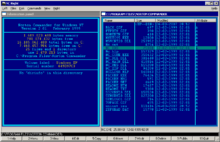Norton Commander
|
Norton Commander v.5.51 for DOS. Note the long file names present when running on Windows. | |
| Original author(s) | John Socha |
|---|---|
| Initial release | 1986 |
| Last release |
5.51
/ 1 July 1998 |
| Development status | Discontinued |
| Operating system | DOS |
| Type | File manager |
| License | Commercial proprietary software |
Norton Commander (NC) is a discontinued prototypical orthodox file manager (OFM), written by John Socha and released by Peter Norton Computing (later acquired in 1990 by the Symantec corporation). NC is a file manager which provides a text-based user interface on top of DOS. It was officially produced between 1986 and 1998. The last DOS version of Norton Commander, 5.51, was released on July 1, 1998.
A related product, Norton Desktop, a graphical shell for DOS and Windows, succeeded Norton Commander. It came in two variants, Norton Desktop for DOS and Norton Desktop for Windows.
Background

Norton Commander was easy to use because it had a constant view of two file manipulation objects at once. After starting the program the user sees two panels with file lists. Each panel can be easily configured to show information about the other panel, a directory tree, or a number of other options. At the bottom of the screen, Norton Commander displays a list of commands that are extended on demand by the CTRL and ALT keys. Thus, without heavy use of the mouse (although mouse functionality was integrated around version 3.0), the user is able to perform many file manipulation actions quickly and efficiently. Additionally, it also includes a built-in text file viewer (invoked with F3 key) and text file editor (invoked with F4 key).
Long filenames
Windows 95 included a new graphical shell called Windows Explorer and supported long filenames (LFN). Symantec released Norton Commander 5.51 to support long filenames using the standard Windows APIs. In order to preserve LFNs while working in real mode, Norton Commander 5.51 required the use of a Terminate and Stay Resident (TSR) utility. Norton Commander did not have native support for LFNs in real mode and would truncate them.
Despite the decline in its use, Norton Commander was very popular during the DOS era and it has been extensively cloned. For example, the IntelliJ IDE has a "Commander" window (complete with a uniformed man icon) that performs file manipulation using the same shortcut keys as Norton Commander.[1]
End of life
According to former Peter Norton Group developer Mark Lowlier, after Symantec had acquired Peter Norton Computing, Symantec had speculated Microsoft Windows would be a success, so the key PNC resources had been diverted, while new programmers for Windows platform were hired. Enrique Salem (who eventually became Symantec's CEO) lead the development of a File Manager and Program Manager released as Norton Desktop for Windows.
Norton Commander for Windows
Norton Commander for Windows was a Windows 95 variant of the classical DOS file manager.
1.0
Version 1.0 was first released in 1996. It supported both Windows 95 and Windows NT.
This version fully integrated with Windows features such as the Recycle Bin and Quick View. Quick View feature was supported via the included basic Quick View Plus.
Version 1.02 added Windows 98 support.
2.0

Version 2.0 was released in 2000. It supports Windows 2000 and functions under Windows XP, Windows Vista, and Windows 7. Installer included Network Utilities, Norton Commander Scheduler, and the Norton Commander.
Network Utilities allows for viewing devices and systems on network, connecting to remote systems, mapping network drives, network monitoring, and more.
Norton Commander is little changed from previous versions, and includes file compression/de-compression of various formats, network utilities access, disk cleanup, files and folder compare, FTP connection management, and more.
The last Windows version of Norton Commander was 2.01.
Norton Commander for OS/2
Version 1.0 was released in December 1992. It supports OS/2 2.0 with HPFS or FAT file system.
It does not include the command prompt found in other versions of Norton Commander.
In June 1993, Symantec lowered the price of Norton Commander for OS/2 to $49, and soon ceased sales.
Norton Commander inspired software
There are several programs that follow the style of Norton Commander. Examples are:
- Altap Salamander for Windows
- Demos Commander for Unix and Linux
- Directory Opus for Amiga (1990) and Windows (2001)
- DOS Command Center (DCC) DOS and Win95 Versions
- DOS Navigator for DOS
- FAR Manager for Windows
- File Commander for Windows and OS/2
- GNOME Commander for Unix-like systems
- Krusader for Unix-like systems
- Midnight Commander for Unix-like systems including macOS and Windows
- muCommander for Java platform
- PowerDesk by Avanquest, of which an evaluation version of Version 4 is included in Microsoft's Windows NT 4.0 Resource Kits
- The DOS Controller by Søren Kragh
- Total Commander for Windows
- Volkov Commander for DOS
- Music on Console for Unix-like systems; actually a music player
- WinNC for Windows 10
- Xfolders for OS X
See also
References
- ↑ "Commander Tool Window". Retrieved 9 August 2012.
External links
- The History of Development of Norton Commander (Softpanorama)
- 21st Century Nostalgia A Tribute to Norton Commander 5.0
- Norton Desktop for Windows 1.0 A graphical review in the GUI Gallery
